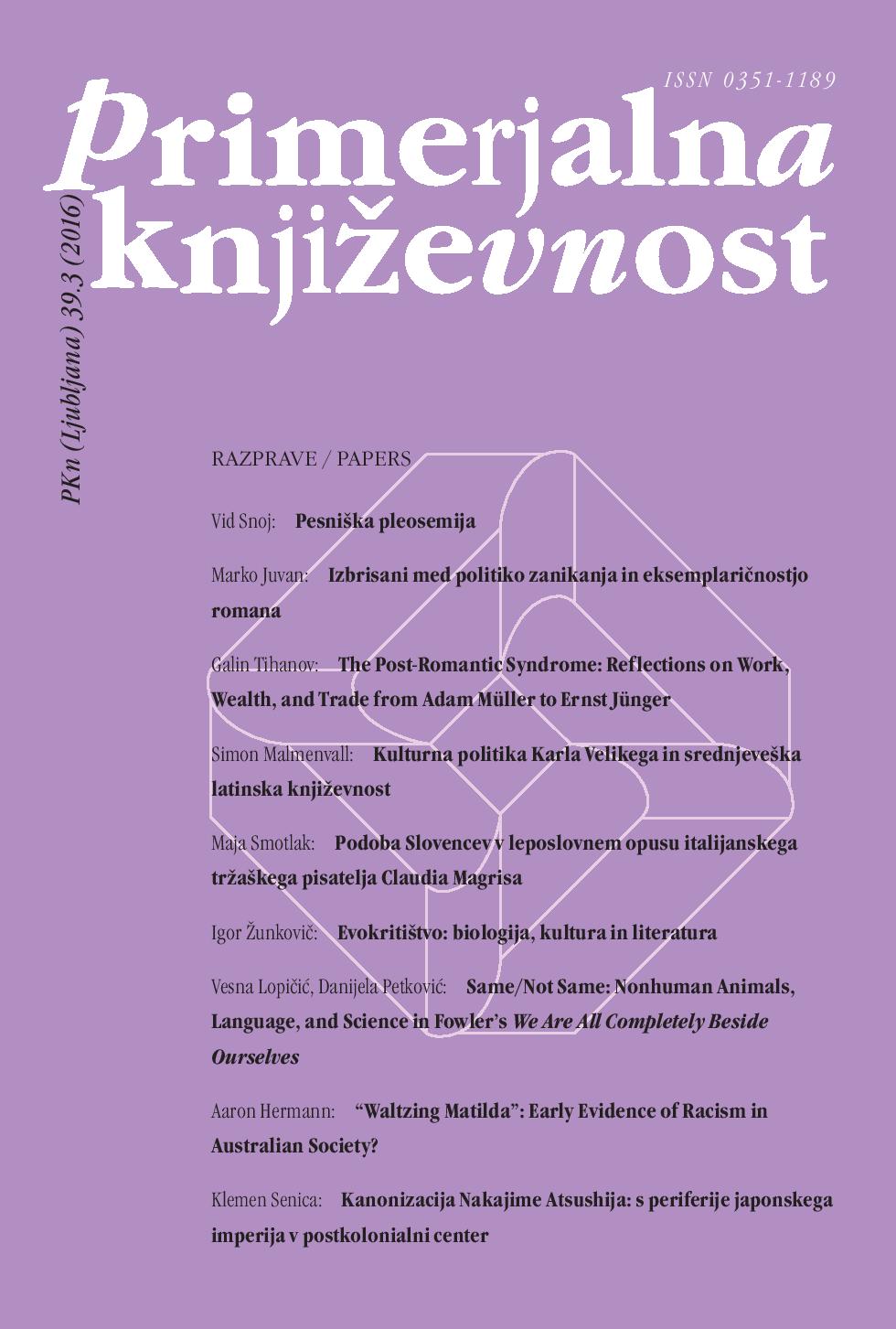Pleosemy in Poetry
Keywords:
poetry, poetic language, everyday discourse, poetic discourse, ambiguity, polysemy, pleosemy, Rilke, Rainer MariaAbstract
This article distinguishes between the “abundance of meaning” (Mehrdeutigkeit) in poetic discourse and the “multitude of meaning” (Vieldeutigkeit) in everyday discourse, both of which are covered by the English term “ambiguity”. The Vieldeutigkeit of everyday discourse is illustrated with an example adduced by Paul de Man from an American TV series, and the Mehrdeutigkeit of poetic discourse is exemplified by Rilke’s famous epitaph. Based on the example of this short poem, which begins with an apostrophe to the rose, the study demonstrates that poetic discourse does not reduce several meanings to a single meaning; rather, the meanings coexist side by side without excluding each other. The highest condensation of meaning in Rilke’s poem occurs in the word Lust, which may be read in three ways: as referring to the rose, to the speaker (Rilke himself), or to the deceased in his grave. The study traces Rilke’s poem in its segueing from one meaning to another and concludes by suggesting a name for poetic ambiguity. As a counterpart to Vieldeutigkeit, which literally corresponds to the Greek word polysemy, an analogous coinage for Mehrdeutigkeit might be pleosemy, with pleo(n)- denoting the excessive and abundant poetic “more”.References
Asín Palacios, Miguel. La escatología musulmana en la Divina Comedia. Madrid: Impr. de E. Maestre, 1943 (2. izd.).
Böschenstein, Bernhard. Von Morgen nach Abend. Filiationen der Dichtung von Hölderlin zu Celan. München: Wilhelm Fink Verlag, 2006.
Bullock-Kimball, Beatrice Susanne. The Heritage of Rose Symbolism and Rose Metaphors in View of Rilke’s Epitaph Rose. New York itn.: Peter Lang, 1987.
Celan, Paul. Gesammelte Werke [= GW]. Zv. 1: Gedichte I. Frankfurt ob Majni: Suhrkamp, 1983.
– – –. Celan. Prevedel Niko Grafenauer. Ljubljana: Mladinska knjiga, 1985 (Lirika 57).
Chalfen, Israel. Paul Celan. Eine Biographie seiner Jugend. Frankfurt ob Majni: Suhrkamp, 1979.
Daley, Brian E. The Hope of the Early Church. A Handbook of Patristic Eschatology. Cambridge: Cambridge University Press, 1991.
Dante Alighieri. Tutte le opere. Ur. Luigi Blasucci. Firence: Sansoni editore, 1965.
– – –. Božanska komedija. Prevedel Andrej Capuder. Trst: Založništvo tržaškega tiska, 1991.
Empson, William. Seven Types of Ambiguity. London: Chatto and Windus, 1949 (2. izd.).
Engel, Ulrich. Deutsche Grammatik. Heidelberg: Julius Groos Verlag, 1996 (3., popravljena izd.).
Ferber, Michael. A Dictionary of Literary Symbols. Cambridge itn.: Cambridge University Press, 2007 (2. izd.).
Gilson, Étienne. Duh srednjeveške filozofije. Prevedel Janez Zupet. Ljubljana: Družina, 2002.
Hamburger, Käte. »Die phänomenologische Struktur der Dichtung Rilkes«. Zeitschrift für Ästhetik und allgemeine Kunstwissenschaft 19 (1966): 217–234.
Heidegger, Martin. »Wozu Dichter?« Gesamtausgabe. Zv. 5: Holzwege. Izd. Friedrich-Wilhelm von Herrmann. Frankfurt ob Majni: Vittorio Klostermann, 1977. 265–316.
-– – –. Gesamtausgabe. Zv. 10: Der Satz vom Grund. Izd. Petra Jaeger. Frankfurt ob Majni: Vittorio Klostermann, 1997.
Hentschel, Elke (ur.). Deutsche Grammatik. Berlin in New York: Walter de Gruyter, 2010.
Holthusen, Hans Egon. Der unbehauste Mensch. Motive und Probleme der modernen Literatur. München: Piper Verlag, 1951.
Lansing, Richard (ur.). The Dante Encyclopedia. New York in London: Garland Publishing, Inc., 2000.
Liddell–Scott–Jones. A Greek-English Lexicon. With a Revised Supplement. Oxford: Clarendon Press, 1996 (9. izd.).
de Man, Paul. »Semiology and Rhetoric«. Allegories of Reading. Figural Language in Rousseau, Nietzsche, Rilke, and Proust. New Haven in London: Yale University Press, 1979. 3–19.
Platon. Zbrana dela. 1. zv. Celje: Mohorjeva družba, 2004.
Rilke, Rainer Maria. Briefe. Zv. 2: 1914 bis 1926. Izd. Rilke-Archiv v povezavi z Ruth Sieber-Rilke. Frankfurt ob Majni: Insel Verlag, 1950.
– – –. Sämtliche Werke. Werkausgabe [= SW]. Zv. 1, 3 in 4. Izd. Rilke-Archiv v povezavi z Ruth Sieber-Rilke. Frankfurt ob Majni: Insel Verlag, 1955–1966.
– – –. Zapiski M. L. Briggeja. Prevedel Niko Grafenauer. Ljubljana: Državna založba Slovenije, 1977.
– – –. Pesmi. Prevedel Kajetan Kovič. Ljubljana: Državna založba Slovenije, 1977.
Rilke, Rainer Maria. Prevedel Kajetan Kovič. Ljubljana: Mladinska knjiga, 1988 (Lirika 62).
Sandbank, Shimon. »The Sign of the Rose: Vaughan, Rilke, Celan«. Comparative Literature 49.3 (1997): 195–208.
Shakespeare, William. Hamlet. Prevedel Oton Župančič. Ljubljana: Mladinska knjiga, 1956 (Kondor 5).
Silezij, Angel. Kerubski popotnik. Prevedla Gorazd Kocijančič in Vid Snoj. Ljubljana: KUD Logos, 2012.
Snoj, Vid. »De Manovo branje poezije«. Primerjalna književnost 16.1 (1993): 8–12.
Sveto pismo stare in nove zaveze. Ljubljana: Svetopisemska družba Slovenije, 1996.
Vignaux, Paul. »Présentation«. Dieu et l’être. Exégèses d’Exode 3, 14 et de Coran 20, 11–24. Pariz: Centre d’études des religions du livre, 1978. 7–13.
Wolff, Joachim. Rilkes Grabschrift. Manuskript- und Druckgeschichte, Forschungsbericht, Analysen und Interpretationen. Heidelberg: Lothar Stiehm Verlag, 1983.
Yeats, William Butler. Zbrana poezija (= ZP). Zv. 2: Lirika 1919–1928. Prevedla Nada Grošelj. Ljubljana: Književno društvo Hiša poezije, 2015.


